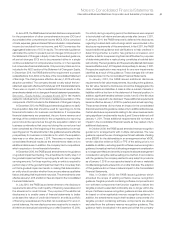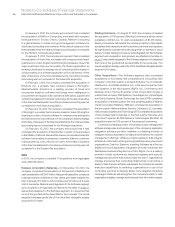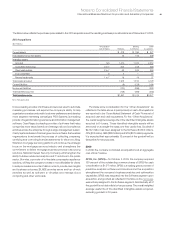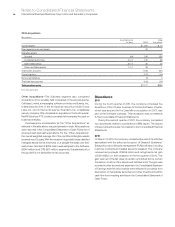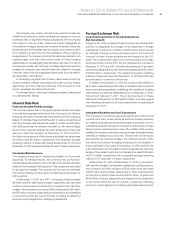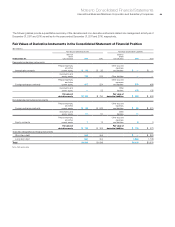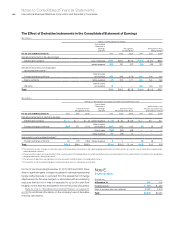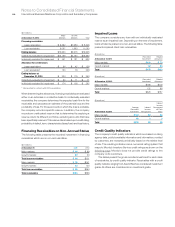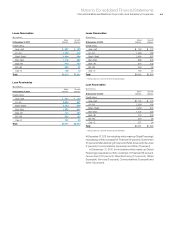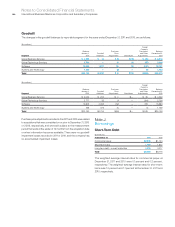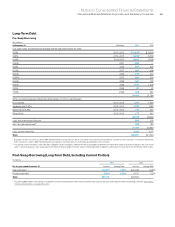IBM 2011 Annual Report Download - page 99
Download and view the complete annual report
Please find page 99 of the 2011 IBM annual report below. You can navigate through the pages in the report by either clicking on the pages listed below, or by using the keyword search tool below to find specific information within the annual report.Notes to Consolidated Financial Statements
International Business Machines Corporation and Subsidiary Companies 97
The company may employ derivative instruments to hedge the
volatility in stockholders’ equity resulting from changes in currency
exchange rates of significant foreign subsidiaries of the company
with respect to the U.S. dollar. These instruments, designated as
net investment hedges, expose the company to liquidity risk as the
derivatives have an immediate cash flow impact upon maturity which
is not offset by a cash flow from the translation of the underlying
hedged equity. The company monitors this cash loss potential on an
ongoing basis, and may discontinue some of these hedging
relationships by de-designating the derivative instrument in order to
manage the liquidity risk. Although not designated as accounting
hedges, the company may utilize derivatives to offset the changes
in the fair value of the de-designated instruments from the date of
de-designation until maturity.
In its hedging programs, the company uses forward contracts,
futures contracts, interest-rate swaps and cross-currency swaps,
depending upon the underlying exposure. The company is not a
party to leveraged derivative instruments.
A brief description of the major hedging programs, categorized
by underlying risk, follows.
Interest Rate Risk
Fixed and Variable Rate Borrowings
The company issues debt in the global capital markets, principally
to fund its financing lease and loan portfolio. Access to cost-effective
financing can result in interest rate mismatches with the underlying
assets. To manage these mismatches and to reduce overall interest
cost, the company uses interest rate swaps to convert specific fixed-
rate debt issuances into variable-rate debt (i.e., fair value hedges)
and to convert specific variable-rate debt issuances into fixed-rate
debt (i.e., cash flow hedges). At December 31, 2011 and 2010,
the total notional amount of the company’s interest rate swaps was
$5.9 billion and $7.1 billion, respectively. The weighted-average
remaining maturity of these instruments at December 31, 2011 and
December 31, 2010 was approximately 5.5 and 5.7 years, respectively.
Forecasted Debt Issuance
The company is exposed to interest rate volatility on future debt
issuances. To manage this risk, the company may use forward-
starting interest rate swaps to lock in the rate on the interest payments
related to the forecasted debt issuance. These swaps are accounted
for as cash flow hedges. The company did not have any derivative
instruments relating to this program outstanding at December 31,
2011 and 2010.
At December 31, 2011 and 2010, net losses of approximately
$5 million and $13 million (before taxes), respectively, were recorded
in other comprehensive income/(loss) in connection with cash flow
hedges of the company’s borrowings. Within these amounts $6 million
and $8 million of losses, respectively, are expected to be reclassified
to net income within the next 12 months, providing an offsetting
economic impact against the underlying transactions.
Foreign Exchange Risk
Long-Term Investments in Foreign Subsidiaries
(Net Investment)
A large portion of the company’s foreign currency denominated debt
portfolio is designated as a hedge of net investment in foreign
subsidiaries to reduce the volatility in stockholders’ equity caused
by changes in foreign currency exchange rates in the functional
currency of major foreign subsidiaries with respect to the U.S.
dollar. The company also uses cross-currency swaps and foreign
exchange forward contracts for this risk management purpose. At
December 31, 2011 and 2010, the total notional amount of derivative
instruments designated as net investment hedges was $5.0 billion
and $1.9 billion, respectively. The weighted-average remaining
maturity of these instruments at December 31, 2011 and 2010 was
approximately 0.4 years for both periods.
In addition, at December 31, 2010, the company had liabilities of
$221 million, representing the fair value of derivative instruments that
were previously designated in qualifying net investment hedging
relationships, but were de-designated prior to December 31, 2010;
this amount matured in 2011. The notional amount of these
instruments at December 31, 2010 was $1.6 billion, including original
and offsetting transactions. No instruments were outstanding at
December 31, 2011.
Anticipated Royalties and Cost Transactions
The company’s operations generate significant nonfunctional
currency, third-party vendor payments and intercompany payments
for royalties and goods and services among the company’s non-U.S.
subsidiaries and with the parent company. In anticipation of these
foreign currency cash flows and in view of the volatility of the currency
markets, the company selectively employs foreign exchange forward
contracts to manage its currency risk. These forward contracts are
accounted for as cash flow hedges. The maximum length of time
over which the company is hedging its exposure to the variability in
future cash flows is four years. At December 31, 2011 and 2010, the
total notional amount of forward contracts designated as cash flow
hedges of forecasted royalty and cost transactions was $10.9 billion
and $11.3 billion, respectively, with a weighted-average remaining
maturity of 0.7 years and 0.8 years, respectively.
At December 31, 2011 and December 31, 2010, in connection
with cash flow hedges of anticipated royalties and cost transactions,
the company recorded net gains of $88 million and net losses
of $147 million (before taxes), respectively, in other comprehensive
income/(loss). Within these amounts $191 million of gains and
$249 million of losses, respectively, are expected to be reclassified
to net income within the next 12 months, providing an offsetting
economic impact against the underlying anticipated transactions.


